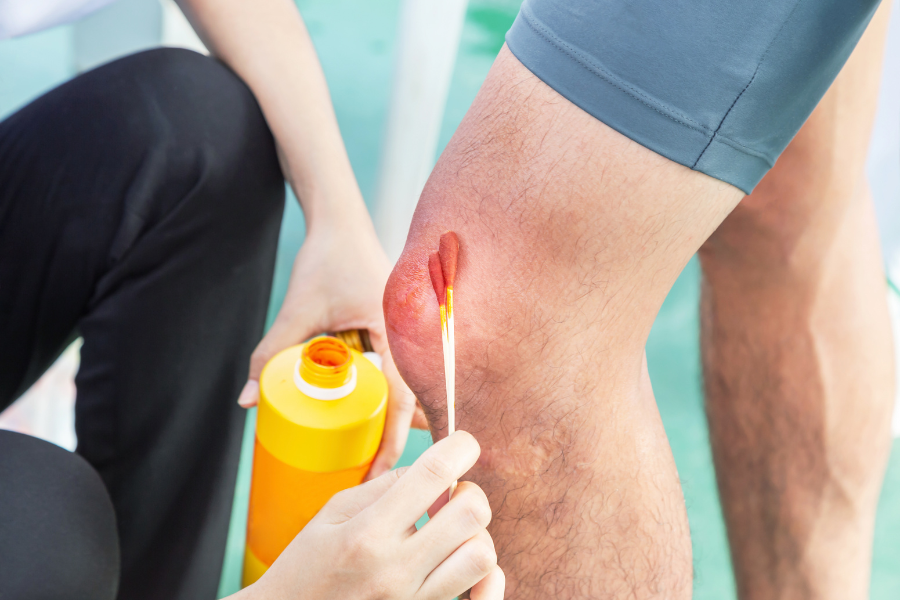 What Is A Venous Ulcer?
What Is A Venous Ulcer?- What Causes Venous Ulcers?
- What Do Venous Ulcers Look and Feel Like?
- Why Is It Important to Seek Venous Ulcer Treatment?
- How Can Venous Ulcers Be Prevented?
Do you or anyone you know have persistent leg wounds that won’t heal? Venous ulcers affect approximately 2 to 5 percent of the population and are responsible for up to 80% of all leg ulcers. These ulcers can be uncomfortable and pose severe health risks.
If left untreated, venous ulcers can significantly impact the quality of life and increase the risk of complications. But what exactly are venous stasis ulcers, and why are they so prevalent?
At Freedom Health & Wellness, we help people who suffer from wounds daily. Learn about venous ulcers, including their symptoms, treatment options, and prevention methods.
What Is A Venous Ulcer?
 Venous ulcers, also known as venous stasis ulcers or non-healing wounds, commonly occur around the ankle or lower leg and can last for weeks, months, or even longer without proper treatment. They frequently come with drainage or discharge, pain, redness, and the presence of yellow, fibrous tissue with irregular borders. These ulcers typically affect individuals with varicose veins or a history of leg swelling.
Venous ulcers, also known as venous stasis ulcers or non-healing wounds, commonly occur around the ankle or lower leg and can last for weeks, months, or even longer without proper treatment. They frequently come with drainage or discharge, pain, redness, and the presence of yellow, fibrous tissue with irregular borders. These ulcers typically affect individuals with varicose veins or a history of leg swelling.
Healing a venous ulcer can take several months; in severe cases, the ulcer may never fully heal. About 20% of venous ulcers do not heal within a year of onset. With appropriate treatment by a healthcare provider skilled in compression therapy for leg ulcers, the majority of venous leg ulcers typically heal within 3 to 4 months.
Blood pooling and increased pressure in the veins result from oxygen-poor blood failing to flow properly from the extremities to the heart, which causes venous ulcers. This, in turn, damages the skin tissue and results in ulceration.
What Causes Venous Ulcers?
Venous ulcers occur due to poor blood circulation in the leg veins. This inadequate blood flow can result from various underlying issues that hinder the healing of wounds or disrupt skin integrity. The valves within the leg veins play an important role in regulating blood flow, and when these valves become damaged, blood flow is compromised, increasing the risk of ulceration.
Several factors contribute to the development of venous ulcers, including:
- Venous hypertension: In normal circumstances, blood pressure decreases in the legs during walking. However, this mechanism fails in venous hypertension, leading to elevated pressure in the veins and subsequent ulcer formation.
- Venous insufficiency: When the leg veins fail to efficiently pump blood back to the heart, blood pools in the legs, causing swelling. Over time, this swelling damages the skin, impeding the body’s healing ability.
- Varicose veins: Dysfunction in the leg vein valves leads to blood pooling in the lower leg, resulting in varicose veins and increasing the risk of ulceration.
- Blood clots: Vein blockages caused by blood clots restrict blood flow to the lower leg, contributing to ulcer development.
- Poor circulation (peripheral artery disease): Reduced blood flow due to circulatory issues slows healing.
- Diabetes, kidney failure, or inflammatory diseases can impair wound healing and exacerbate swelling, increasing susceptibility to ulcers.
- Certain medications: Some medications suppress the immune system or induce swelling, hindering ulcer healing.
- Infections: Infections can impede healing by spreading or entering the bloodstream.
- Obesity: Excessive weight exerts pressure on the leg veins, prolonging the healing process of ulcers.
Who Gets Venous Ulcers?
Several factors can increase your susceptibility to venous ulcers. These include:
 Deep vein thrombosis
Deep vein thrombosis- Family history of venous disease
- Obesity
- Advanced age
- Paralysis
- Previous injury
- Sedentary lifestyle with minimal physical activity
- Smoking
- Surgical procedures, such as knee replacements
- Presence of varicose and spider veins
What Do Venous Ulcers Look and Feel Like?
Venous ulcers typically manifest as shallow, irregularly shaped sores. The skin surrounding the ulcer may exhibit hardness and discoloration.
Symptoms associated with venous ulcers include:
- Dull ache
- Foul odor
- Itching
- Pus or other fluid discharge from the sore
- Swelling (edema)
Why Is It Important To Seek Venous Ulcer Treatment?
Venous ulcers cannot heal on their own and require active treatment. If left untreated for a prolonged period, they can cause permanent tissue damage, leading to serious complications such as infections, including gangrene, which can endanger life or limb.
In severe cases, surgical intervention, such as limb amputation, may be required. However, timely and appropriate care from a skilled wound care provider can significantly reduce the likelihood of such drastic measures.
What Venous Ulcer Treatments Are Available?
 Treatment options for venous ulcers are customized based on the ulcer’s location and severity. Typically, a comprehensive approach involves regular follow-up appointments to assess treatment effectiveness.
Treatment options for venous ulcers are customized based on the ulcer’s location and severity. Typically, a comprehensive approach involves regular follow-up appointments to assess treatment effectiveness.
Common treatments for venous ulcers include:
- Antibiotics: Prescribed to combat infections if present.
- Compression therapy: Utilizing bandages or stockings to enhance circulation.
- Topical ointments: Applied to protect against bacterial growth.
- Pain management: Various therapies aim to alleviate discomfort and soothe nerves.
- Debridement: Surgical removal of dead tissue and debris to facilitate healing.
- Referrals: Specialist consultations may be necessary for managing underlying chronic conditions like diabetes.
- Specialized bandages and dressings: Used to cover and protect the ulcer site.
- Daily wound care: Regular cleaning to eliminate bacteria and remove necrotic tissue.
For severe or unresponsive cases, additional treatments may be recommended, including:
- Growth factor therapy: Injections that promote the migration of healthy cells to the ulcer site.
- Hyperbaric oxygen therapy: A specialized treatment involving pure oxygen inhalation in a pressurized chamber.
- Lymphedema therapy: Techniques such as massage and bandaging to reduce fluid buildup.
- Skin grafting: Transplanting healthy skin from another body part to replace damaged tissue.
- Stem cell therapy: Injections of bone marrow to stimulate tissue regeneration.
- Venous disease interventions are procedures aimed at correcting underlying issues, like blood pooling, to improve circulation and aid in healing.
How Can Venous Ulcers Be Prevented?
Preventive measures can significantly reduce the risk of developing venous stasis ulcers or prevent recurrence after treatment. Consider the following strategies:
- Adhering to treatments for chronic conditions, such as high blood pressure, can impact vein health.
- Maintaining a healthy weight reduces pressure on the veins.
- Quitting smoking is important, as smoking can impair circulation and delay healing.
- If your healthcare provider recommends taking prescribed blood thinners (anticoagulants) to prevent blood clots.
Next Steps for Venous Ulcer Treatment
Venous stasis ulcers can be difficult to manage, but they can be effectively treated and prevented with timely intervention and comprehensive care. If you or a loved one are experiencing symptoms of venous ulcers, don’t hesitate to schedule an appointment with Freedom Health & Wellness today.
Our experienced team is here to provide compassionate and personalized care to help you overcome this condition and improve your quality of life.




